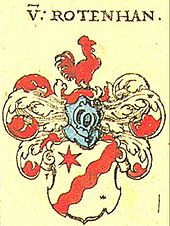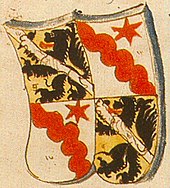Anton von Rotenhan

Anton von Rotenhan (* around 1390 in Rentweinsdorf ; † May 5, 1459 ) was Bishop of Bamberg .
Life
Anton, from the Frankish noble family Rotenhan , became canon of Würzburg and Bamberg in 1398 . In Bamberg he was elected dean of the cathedral in 1431 and when the Bamberg prince-bishop Friedrich III. Von Aufseß resigned his office, Rotenhan was elected as his successor in Staffelstein . (In Staffelstein because at that time the plague raged in Bamberg .) The episcopal ordination took place on August 23, 1434 by his brother, the Lubusz bishop Christoph von Rotenhan .
During Rotenhan's term of office, there were three power blocks in the Bamberg area: the cathedral chapter with the immunities of St. Gangolf , St. Jakob , St. Stephan and the Michelsberg monastery , the bishop, whose interests did not always coincide with those of the cathedral chapter, and the city citizenship . There was a so-called immunity dispute between the cathedral chapter and the citizenship. The epoch in which Anton von Rotenhan's work fell was also the time of the Hussite movement and the councils . His predecessor had given up because he did not trust himself to cope with the difficulties that had emerged.
As a result of an attack by the Hussites, from which they could not protect themselves due to the lack of walling, the Bamberg citizens decided to fortify the city and surround it with walls. In order to raise the necessary funds, the citizens believed that they no longer had to respect the traditional liberation of the subordinates of the founders and the monasteries who lived in the city, the so-called immunities. Emperor Sigismund had expressly recognized the city's fortification rights in a separate document and waived the immunities. There had been a rift between the clergy and the city even before the new bishops were elected and the newly elected had to undertake to reject the arrogance of the citizens. But the city stuck to its position, the walls were built and the reluctant, in part, forced to obey by force. The bishop and his chapter had emigrated and besieged the city after the Council of Basel had declared against them. At last there was a kind of contract between the bishop and the city in which the citizenship got the short straw and the old conditions were restored after Emperor Sigismund also abandoned the city in 1437.
In Bamberg Cathedral there is a sandstone epitaph of Bishop Anton von Rotenhan on the east side of the third pillar of the south aisle .
literature
- Aemilian Ussermann : Episcopatus Bambergensis sub metropoli Moguntina chronologice et diplomatice illustrata. St. Blasien 1801 ( digitized version ).
- Franz Xaver von Wegele : Anton von Rotenhan . In: Allgemeine Deutsche Biographie (ADB). Volume 1, Duncker & Humblot, Leipzig 1875, p. 486 f.
- Erich Freiherr von Guttenberg : Anton. In: New German Biography (NDB). Volume 1, Duncker & Humblot, Berlin 1953, ISBN 3-428-00182-6 , p. 314 f. ( Digitized version ).
- From the Bamberg immunity dispute. In: Rochus von Liliencron : The historical folk songs of the Germans. Volume 1. Vogel, Leipzig 1865, No. 71, pp. 348–352 .
Web links
| predecessor | Office | successor |
|---|---|---|
| Friedrich III. from Aufseß |
Prince-Bishop of Bamberg 1431–1459 |
George I of Schaumberg |
| personal data | |
|---|---|
| SURNAME | Rotenhan, Anton von |
| BRIEF DESCRIPTION | German Roman Catholic Bishop of Bamberg |
| DATE OF BIRTH | around 1390 |
| PLACE OF BIRTH | Rentweinsdorf |
| DATE OF DEATH | May 5, 1459 |

